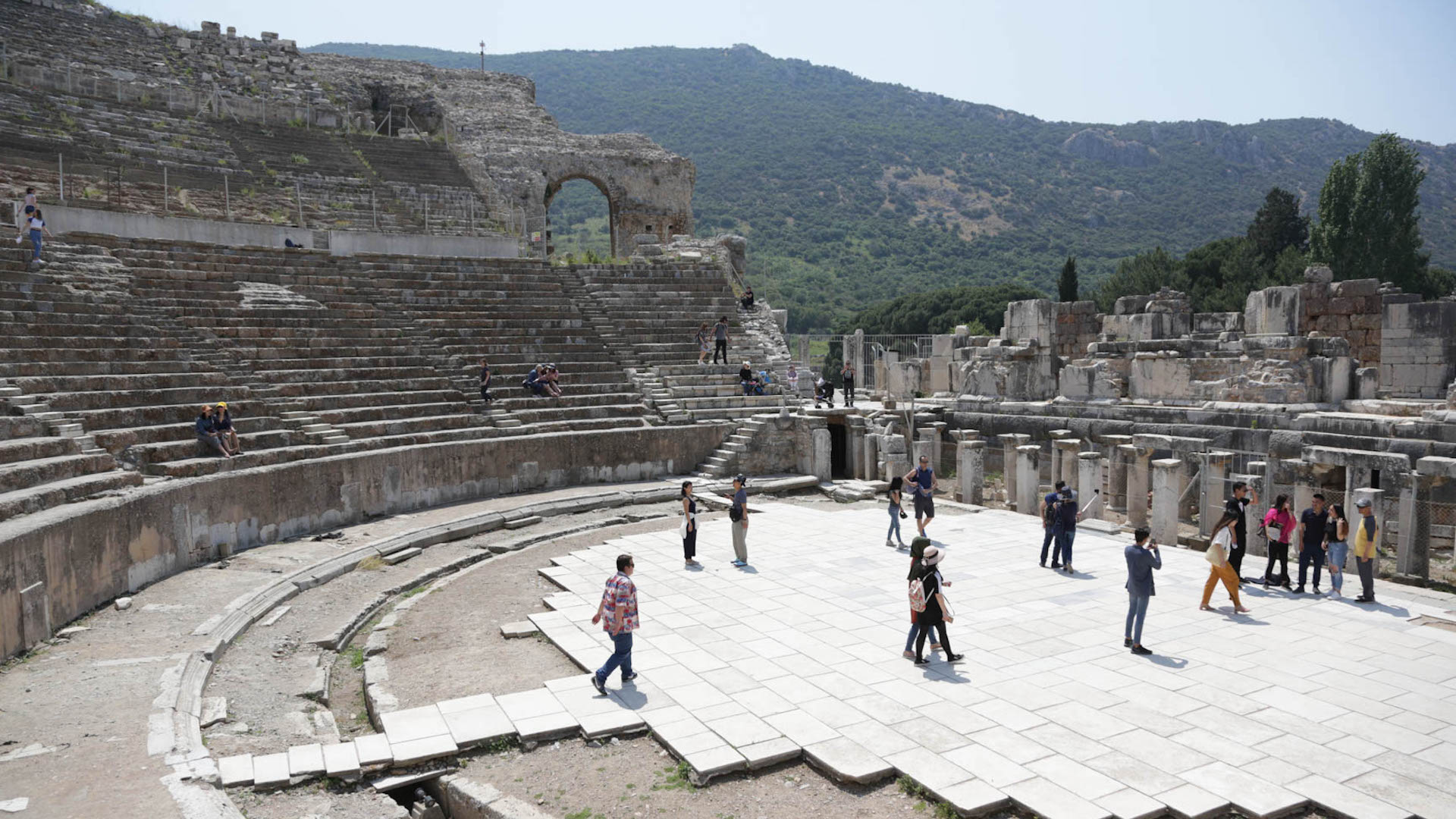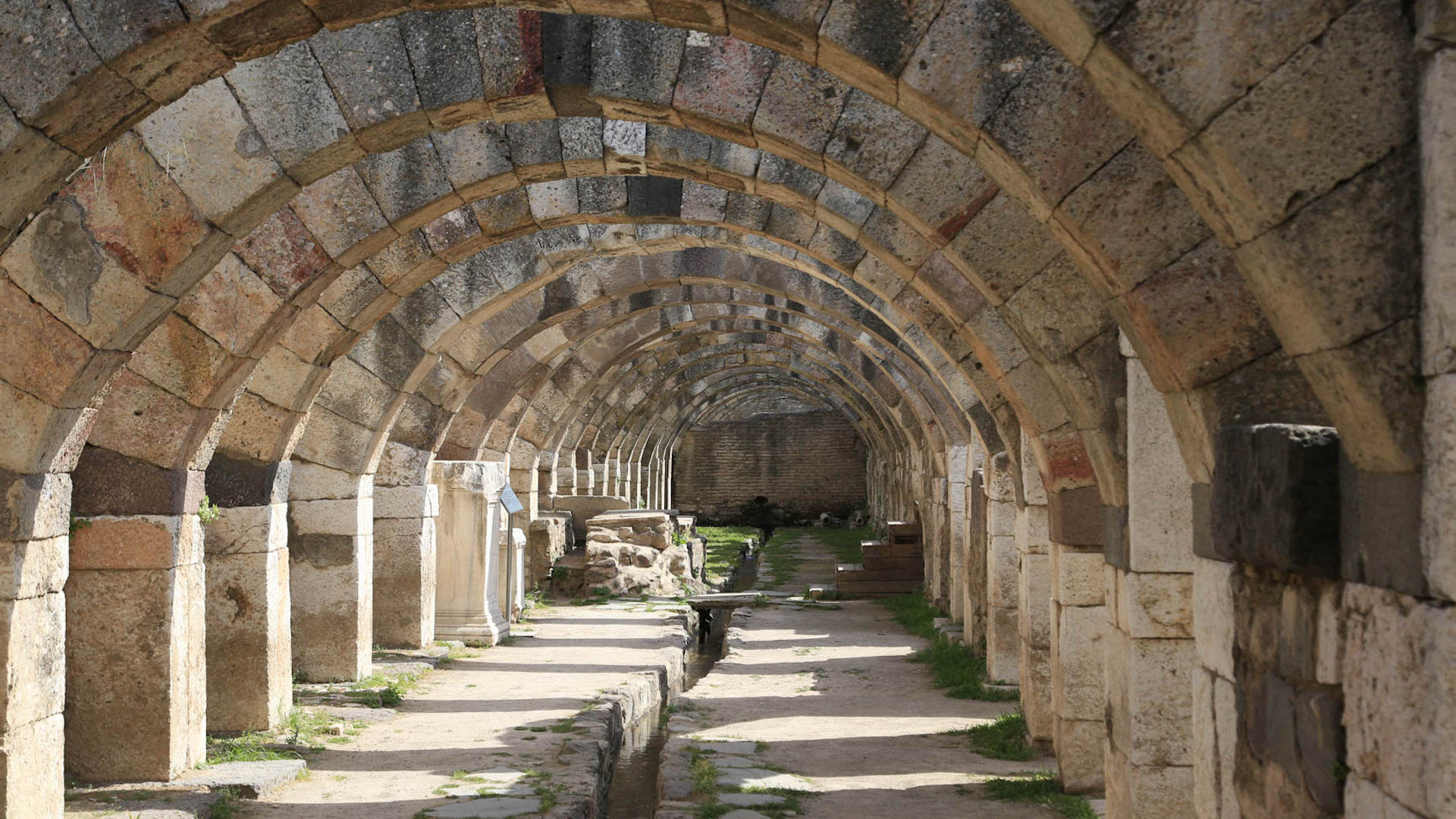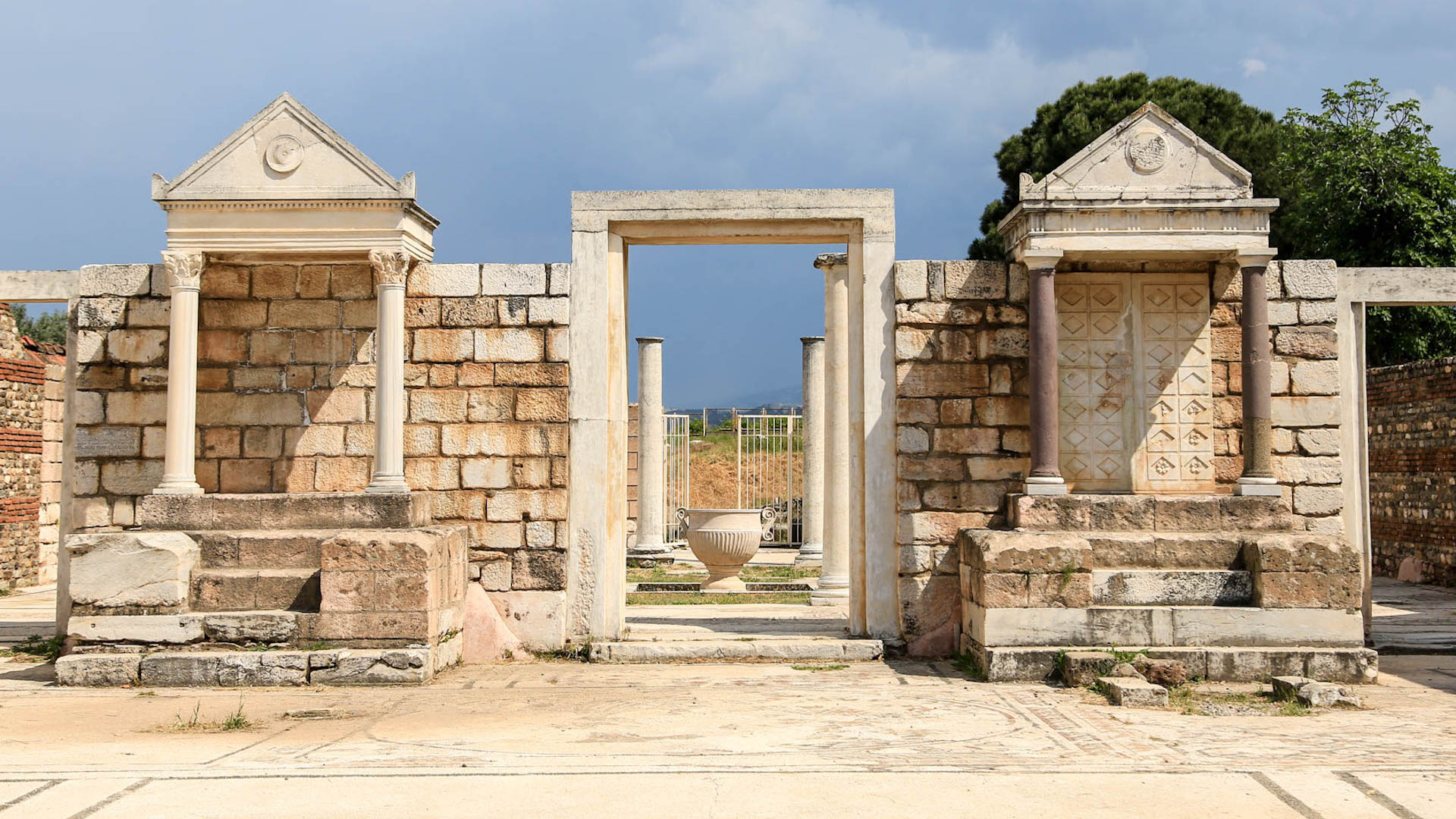
The trip of a lifetime landed in my lap—visiting the Seven Churches of Revelation. Until recently, I didn’t even know all seven churches were located in modern-day Turkey. A friend and I flew to Izmir, Turkey, where we rented a car and drove to all seven churches in a quick, three-day trip.
In the end, we saw a lot of rocks.
Don’t get me wrong. They were beautiful rocks. But they were rocks, ruins of ancient cities once teeming with people long gone. In the apostle John’s vision of Revelation, Jesus spoke to the Christians in these cities, commending some but warning most. As I read Jesus’s words to the seven churches and learned about each location, I wondered how these rocks should change my life.
Ephesus-Selçuk
Ephesus was the fourth largest city of the Roman empire in the first century. A thriving commercial center and port city, Ephesus was also the home of a temple to the goddess Artemis. The amphitheater in Ephesus, which could hold up to twenty-five thousand people, was the venue of the angry riot against Christians in Acts 19.

The amphitheater where the riot in Acts 19 broke out has also been the venue for rallies and concerts. Sting, Elton John, and Diana Ross are among those who have performed there. Photo by Karrie Sparrow.
In Revelation, Jesus commended the Ephesian church for enduring hardships and hating the heresy of the Nicolaitans—early Gnostics who wanted to blend Christianity with pagan practices like sexual immorality. But others in Ephesus had fallen from their first love of Christ and received a sober warning: “Repent and do the things you did at first” (Rev. 2:5 NIV). Some scholars think these Christians may have caved to pressure to worship at the cult temple of Emperor Domitian.

The remains of a temple possibly built for Emperor Domitian during the first century. Domitian persecuted the early church and is responsible for exiling the apostle John to Patmos. Photo by Karrie Sparrow.
Over time, Ephesus physically shifted to what is now the small town of Selçuk, only a five-minute drive from the Ephesus ruins. Honeysuckle perfumed the air around the shops and streets I visited. The town is Muslim—as is 99 percent of Turkey. Even so, a small Protestant church of former-Muslim believers gathers in Selçuk for worship and fellowship.

Prolific, fragrant honeysuckle arches over shops of Selcuk, Turkey. Photo by Karrie Sparrow.
Smyrna-Izmir
The ruins of Smyrna’s marketplace are nestled in a city block of the thriving seaport city, Izmir. One of the oldest continuously inhabited cities of the world, Izmir is now home to more than four million people. When we pulled up to the ruins of ancient Smyrna’s marketplace, high school students spilled out from their school. They seemed ambivalent to the millennia-old city ruins across the street from them.

Horizontal lines of a current-day parking garage in Izmir, Turkey contrast with the vertical columns that hemmed in a marketplace of ancient Smyrna. Photo by Karrie Sparrow.
Jesus’s words to the believers in Smyrna encouraged them in the face of coming persecution. “Be faithful, even to the point of death, and I will give you life as your victor’s crown” (Rev. 2:10 NIV). Indeed, not just in Smyrna but across the entire region, first-century believers who resisted the pressure of imperial cult worship endured persecution. Some scholars think this persecution was often economic, like the loss of a job or financial wealth (Fairchild, p. 146). Probably for this reason, Jesus reminded them they are spiritually rich even though materially poor.

The ancient marketplace of Smyrna still features beautiful arches and running water, which had been collected into cisterns for city use in ancient times. Photo by Karrie Sparrow.
The early church father Polycarp was the bishop of Smyrna and a disciple of the apostle John. At the age of eighty-six, he was burned at the stake for refusing to renounce his faith in Christ. Some of Polycarp’s last words were, “For eighty-six years I have been his servant, and he has done me no wrong. How can I blaspheme my King who saved me?” (Wilson, p. 311).

The modernity of Izmir’s shopping promenades stands in stark contrast to the arrangement of ancient Smyrna’s marketplaces. Photo by Karrie Sparrow.
The modern city of Izmir is filled with secular modernists—officially Muslim by name but sincerely disillusioned with Islam and the current political climate. They may know that Christians “used to” live in Izmir, but most are unaware of the thriving Christian community of up to five hundred believers scattered among at least twelve churches. Although many of these churches are historically Catholic or Orthodox, there is a growing number of evangelical Protestant believers as well.

Mosque minarets, Turkish flags, and palm trees line the hills of the ancient city of Smyrna, now Izmir, Turkey. Photo by Karrie Sparrow.
Pergamum-Bergama
The ruins of Pergamum sit atop a hill overlooking the modern-day city of Bergama. A state-of-the-art cable car carried us to the top of the hill where we viewed extensively excavated ruins. Pergamum was a principal city of the Roman empire in the first century. The most striking remnant is the steep theatre built into the side of the hill.

The acropolis and an ancient amphitheater that seats ten thousand people overlook the city of Pergamum, now modern-day Bergama, Turkey. Photo by Karrie Sparrow.
But it was the ruins of the temple to Zeus that sobered me. Some think this temple is why Jesus called Pergamum the place where Satan has his throne. Jesus had some serious warnings toward Christians in Pergamum who had fallen away from his teaching to embrace sinful behaviors. If they did not repent, Jesus himself would come and fight against them. Jesus did, however, commend the few in Pergamum who stood strong and didn’t renounce their faith even when their friend Antipas was killed (Rev. 2:13).

The temple of the Roman emperor Trajan was used for the worship of Zeus on the upper acropolis of Pergamum, Turkey. Photo by Karrie Sparrow.
Today, Bergama is made up of an “old city” of narrow, cobbled streets and a more modern city. The locals I interacted with didn’t disappoint as they extended their famous Turkish hospitality. Happy to offer information, one man told me Christians visit the seven churches like Muslims visit Mecca—to earn merit before God. My heart dropped to hear his misunderstanding of Christianity. Today, there are a few known believers around Bergama, but no churches.

The way to the Asclepion of Pergamum, perhaps the ancient world’s most famous medical center. Photo by Karrie Sparrow.
Thyatira-Akhisar
In the book of Acts, Lydia was a wealthy benefactress and convert to Christianity. A seller of purple cloth, Lydia’s original home was the city of Thyatira. The ancient coins of Thyatira show a multitude of guilds including linen weavers, bronze workers, potters, and bakers. Thyatira was the only city of the Seven Churches built on flat ground without natural defenses, making it vulnerable to attack. In John’s vision, Jesus is described with feet like burnished bronze—a metaphor Thyatira citizens would have easily grasped because of its bronze workers.

Ruins from an unknown ancient structure remain fenced-off from modern-day life in Akhisar. Photo by Karrie Sparrow.
Jesus warned those in Thyatira who were tolerating the deceptive teaching of “Jezebel,” an unrepentant influencer or perhaps a symbol for the licentiousness that led people into Satan’s “deep secrets” (Rev. 2:20, 24 NIV). Few in Thyatira had remained true to the faith, and Jesus encouraged them to “hold on” (Rev. 2:25 NIV). He promised authority over nations to those who persevere until the end.

An apartment building overlooks the crumbled walls of ancient Thyatira. It’s possible Paul and Silas visited Thyatira during their second or third missionary journey. Photo by Karrie Sparrow.
The scant ruins of Thyatira are unearthed in the modern city of Akhisar. Contemporary apartment buildings line streets teeming with busses and cars. There is no church in Akhisar and no known believers.

Today, more than one hundred thousand people live in Akhisar. The city is well known for its olive and textile industries. Photo by Karrie Sparrow.
Sardis-Sart
We parked our car—the only vehicle in the gravel lot at the ruins of Sardis—and climbed out to view the extensive excavations. The legendary, wealthy King Croesus, who amassed gold from a nearby river, reigned from Sardis in the 500s BC. Ruins from an Artemis temple—originally dating from the fifth century BC and rebuilt by Alexander the Great one hundred years later—still stand today. A stadium, shops, and ruins of the largest ancient Jewish synagogue in the world were a short jaunt from the temple. At the time of John’s vision in Revelation, Sardis was one of the wealthiest Roman cities despite having been rebuilt multiple times after devastating earthquakes.

The Jewish synagogue in Sart was in use for up to six hundred years. Many believe it serves as proof that Judaism remained strong even as Christianity was introduced in the region. Photo by Karrie Sparrow.
Jesus’s words in Revelation sliced through Sardis’s thriving “health” to the church’s spiritual realities. Although there were a faithful few, most people in the Sardis church were spiritually dead and dying. Christ summoned them to “wake up,” “remember,” and “repent” (Rev. 3:2–3 NIV). Ruins from a small, fourth-century Byzantine church stand on the grounds of the Temple of Artemis. I found the crumbling church—built a few hundred years after John’s letter—to be a hopeful sign that some in Sardis took the warning to repent.

Construction and use of the Temple of Artemis in Sardis began during the time of Alexander the Great, near fourth century BC. The temple was still unfinished by the fourth century AD and was all but abandoned when Christianity entered Sardis. Photo by Karrie Sparrow.
The modern town of Sart—only a mile from the ruins—has just over five thousand inhabitants. A nearby village, adjacent to the ruins, carries on with rural life. Children run in the dusty streets. Farmers drive tractors into the surrounding fields. There are no known Christians in Sart today.

Modern-day Sart is a quiet town with nearly five thousand residents. There are no known believers. Photo by Karrie Sparrow.
Philadelphia-Alaşehir
Little remains from ancient Philadelphia. Not established until the mid-100s BC, the city of Philadelphia was the newest of churches Jesus addressed in Revelation. The modern city of Alaşehir stands on top of Philadelphia. You have to look carefully to find any signs of the city’s former life. Crumbling Byzantine walls blend into its cityscape. One neighborhood has preserved the arches and sarcophagi from a sixth-century church. The call to prayer from the adjacent mosque interrupted our reverie as we perused the sparse ruins.

This broken archway, now with a mosque in the background, is believed to have supported a church dome in ancient Philadelphia. Photo by Karrie Sparrow.
I felt uncomfortable with a spiritual weight in Alaşehir. I tried to reconcile that feeling with the knowledge that this is where faithful believers were praised by Jesus, who said, “I know that you have little strength, yet you have kept my word and have not denied my name (Rev. 3:8 NIV).”

Sarcophagi and other antiquities reside in a small city block in Alaşehir, Turkey, the ancient city of Philadelphia. Photo by Karrie Sparrow.
Jesus also told the church in Philadelphia he would keep them from the hour of trial. Whatever that refers to, it did not mean they would be spared persecution. Accounts report that eleven Christians from Philadelphia were martyred alongside Polycarp in 156 AD.

Philadelphia, the city of brotherly love, is now called Alasehir, which some believe to mean “city of Allah.” Photo by Karrie Sparrow.
Laodicea-Denizli
Ongoing excavations of the city of Laodicea began only recently, in 2003. The work continues to uncover an expansive, wealthy city. Laodicea was built on a major highway and became a commercial and banking center. It was known for ear and eye medicine and for its black wool. The water was tepid and unpleasant, but nearby Hierapolis gushed hot thermal springs. Also nearby, Colossae was the home of pure, cold water.

The church of Laodicea is still under excavation. Before the city was named Laodicea, it was called “Diopolis,” the “city of Zeus.” Photo by Karrie Sparrow.
The churches in Hierapolis, Colossae, and Laodicea were relatively close and seemed to have a relationship with one other. Paul instructed that his letter to the Colossians be read also in Laodicea (Col. 4:16), and he was encouraged by their strong faith in Christ (Col. 2:5). Something seems to have changed, however, in the thirty years after Paul’s letter when John penned the book of Revelation. Wealth and independence had weakened their commitment to Christ.

Little is known about what has been unearthed in ancient Laodicea because excavation efforts are relatively new. Archaeologists currently believe this area served as a marketplace. Photo by Karrie Sparrow.
In Revelation 3, Jesus used language and imagery familiar to them: riches, eye medicine, white clothing, and tepid water. He said, “I know your deeds, that you are neither cold nor hot. I wish you were either one or the other! So, because you are lukewarm—neither hot nor cold—I am about to spit you out of my mouth. You say, ‘I am rich; I have acquired wealth and do not need a thing.’ But you do not realize that you are wretched, pitiful, poor, blind and naked” (Rev. 3:15–17 NIV).

Laodicea was established along a busy trade route. This ancient path, known as Syria Street, connected Laodicea to Colossae. Photo by Karrie Sparrow.
Most citizens of Laodicea resettled into the modern-day city of Denizli after a devastating earthquake in 600 AD. It seems the ancient city fully died out after the Turks came through in the eleventh century. Today Denizli is a bustling city of over half a million. Out of that number, three or four former Muslims have stepped out to profess faith in Christ.
Lessons from Rocks
In the subsequent days after our trip, I’ve processed a few lessons to learn from these ancient ruins and from the letters to the seven churches.
Remember Jesus
This Jesus of the first century is the same Jesus of today. He is described in these letters as the one who walks among the churches (Rev. 2:1), the First and the Last, and the One who was dead and came to life (Rev. 2:8), the one who has the sharp, double-edged sword (Rev. 2:12), the one whose eyes are like a fiery flame and whose feet are like fine bronze (Rev. 2:18), the Holy and the True One (Rev. 3:7), the Amen, and the faithful and true Witness (Rev. 3:14). Although these letters occurred at a specific point in antiquity, they bring so much more than historical facts to those who are listening. They are the words of the Living One, and they bear weight on our devotion to him today.
Beware of falling
Jesus couldn’t make it any clearer: following him requires our all. The believers of the first century felt the constant social pressure to compromise their faith by worshiping the emperor in cult worship, tolerating false teachers, and leading lifestyles that mirrored the pagan world around them.
Has anything really changed in the past two thousand years? We may not have neighborhood temples, but Christians today feel pressures to compromise in similar ways. Discipleship of Christ is serious stuff that requires an unrelenting commitment to our only Lord. We must always choose the way of the cross.
Endure to the end
The Christian life is one of mountains and valleys. If we don’t keep a long-term perspective, we will become quickly discouraged and fall away. Christ speaks often of endurance in his letters. “Be faithful until death,” he encouraged the church in Smyrna. Those who endure to the end are called victors and will share in Christ’s glory (Rev. 3:21). Let’s take heart from the faithful examples of those who have gone before us and persevere in fidelity to Christ until our final breath.
Expect God to raise up others
The people of Turkey are not the same ethnic people of the first century. A Muslim people, Turks are proud of their final overthrow of the Christian Byzantine Empire in 1453. Yet God’s church is growing. Throughout the many small towns like Bergama scattered across Turkey, men and women are searching for God. In 2017, almost ten thousand individuals answered an ad to receive a New Testament in the mail. God is raising up his church in this ancient land.
Many of the ruins we visited were desolate. It was just my friend, me, and the lizards among the ancient stones. I remembered Jesus’s words to the Pharisees who wanted him to rebuke those who cried, “Blessed is the King who comes in the name of the Lord!” Jesus told them, “If they keep quiet, the stones will cry out” (Luke 19:38, 40 NIV).
And so they do. Even stones built for pagan worship cry out that Jesus is King. He is building his church, and I want him to find me—find us—faithful in the end.
Want to see more photos from our Seven Churches of Revelation tour? Click here.
Madeline Arthington is a writer living in Central Asia. Karrie Sparrow is a photographer and has worked with the IMB in Central Asia for the past eleven years.
Sources
Christian Origins in Ephesus and Asia Minor by Mark R. Fairchild
Biblical Sites in Turkey by Everett C. Blake and Anna G. Edmonds
Biblical Turkey: A Guide to the Jewish and Christian Sites of Asia Minor by Mark Wilson
A Guide to the Seven Churches by Fatih Cimok

